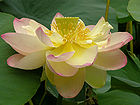- Amitayurdhyana Sutra
-
Lands India • China • Japan
Vietnam • Korea
Singapore • Taiwan
Tibet • Bhutan • Nepal
Mongolia • United StatesDoctrine Bodhisattva • Śīla
Samādhi • Prajñā
Śunyatā • TrikāyaMahāyāna Sūtras Prajñāpāramitā Sūtras
Lotus Sūtra
Nirvāṇa Sūtra
Saṃdhinirmocana Sūtra
Avataṃsaka Sūtra
Śūraṅgama SūtraMahāyāna Schools Mādhyamaka
Yogācāra
Esoteric Buddhism
Pure Land • Zen
Tiantai • Nichiren
The Amitāyurdhyāna Sūtra (Sanskrit; traditional Chinese: 佛說觀無量壽佛經; simplified Chinese: 佛说观无量寿佛经; pinyin: fó shuō guān wúliàngshòufó jīng; Japanese: 観無量寿経), is one of the three major Buddhist sūtras found within the Pure Land branch of Mahāyāna Buddhism. Amitāyus is another name for the buddha Amitābha, the preeminent figure in Pure Land Buddhism, and this sūtra focuses mainly on meditations involving complex visualization. This is reflected in the name of the sūtra, which translates to the "Amitāyus Meditation Sūtra."Contents
Basic Outline of the Sutra
Preliminary matters
The text begins with a story where a prince named Ajatasatru was enticed by the villain Devadatta to murder his father, King Bimbisara, in order to ascend the throne. Ajatasatru kills his father, and nearly kills his mother, Queen Vaidehi, but after advice from his other ministers, he relented and threw his mother in prison.
Lamenting her fate, Queen Vaidehi prays to the Buddha for help, and he is able to visit her. Vaidehi expresses her wish to be born in Amitābha Buddha's Pure Land. Shakyamuni smiles, emitting light from his mouth, and goes on to tell Vaidehi how to be reborn in the Pure Land. The Buddha tells her that although she is in prison, she could still obtain liberation through the practices of Amitābha Buddha. The Buddha goes on to describe Amitābha and how one could obtain rebirth in his land of Sukhavati.
Attaining birth in the Pure Land
Shakyamuni explains the importance of performing certain meritorious acts in order to be reborn in the Pure Land. He then goes on to teach Vaidehi how to visualize the Pure Land, to further her efforts in attaining rebirth there. Shakyamuni describes thirteen "contemplations," or mental visualization exercises, that are to be followed in order. By deeply contemplating various aspects of the Pure Land and attempting to visualize them in detail, the aspirant draws closer to the Pure Land.
The thirteen contemplations are described in order as follows:
- Contemplation of the setting sun
- Contemplation of an expanse of water
- Contemplation of the ground in the Pure Land
- Contemplation of trees in the Pure Land
- Contemplation of ponds in the Pure Land
- Contemplation of various objects in the Pure Land
- Contemplation of the lotus-throne of the Buddha
- Contemplation of the image of Amitabha Buddha
- Contemplation of Amitabha Buddha himself
- Contemplation of Avalokiteshvara
- Contemplation of Mahasthamaprapta
- Contemplation of the aspirants to the Pure Land
- Contemplation of Amitabha and the two bodhisattvas
Nine levels of birth
In the final part of the sutra, Shakyamuni Buddha discusses the nine levels into which those born into the Pure Land are categorized. The levels are ranked from highest to lowest as follows:
- The highest level of the highest grade
- The middle level of the highest grade
- The lowest level of the highest grade
- The highest level of the middle grade
- The middle level of the middle grade
- The lowest level of the middle grade
- The highest level of the lowest grade
- The middle level of the lowest grade
- The lowest level of the lowest grade
According to Shakyamuni Buddha, all nine grades of human beings can achieve rebirth into the Pure Land if they contemplate Amitabha Buddha, or at least call on his name. This is similar to the 48 Vows made by Amitabha Buddha, according to the Larger Sutra of Immeasurable Life, which includes the Primal Vow.
Conclusion
The sutra ends with a short section describing the benefits gained by those who listened to these words of the Buddha. Vaidehi experienced "great awakening with clarity of mind and reached the insight into the non-arising of all dharmas," while her five hundred female attendants and "innumerable devas" also awakened aspiration for the highest enlightenment. Shakyamuni names the sutra, mentions benefits connected with the name of Amitabha Buddha, and exhorts all to hold the words of the sutra in their minds. Shakyamuni then returns through the air to Vulture Peak.
Other Pure Land sutras
See also
Notes
External links
- The Contemplation Sutra, translated into English by J. Takakusu
- English translation of the Contemplation Sutra
- The Taima Mandala Image of the Pure Land from a medieval Japanese scroll, based on the descriptions found in the Contemplation Sutra. This site offers explanations in English of the various motifs of the scroll.
Categories:
Wikimedia Foundation. 2010.

